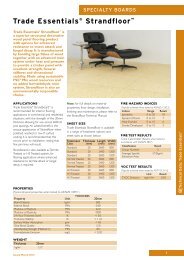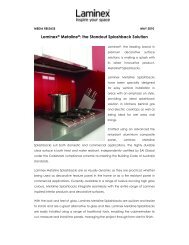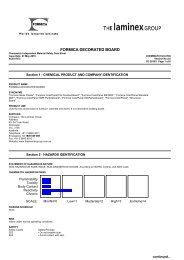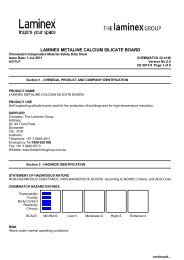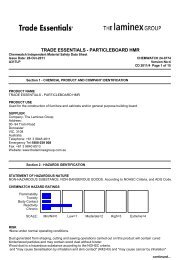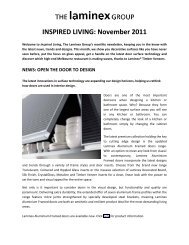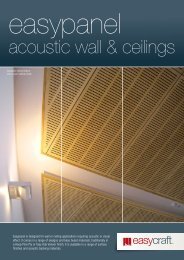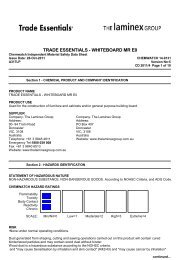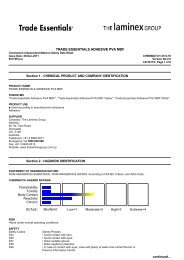Laminex Finished DTV - Gloss - Panel MSDS 6614-22
Laminex Finished DTV - Gloss - Panel MSDS 6614-22
Laminex Finished DTV - Gloss - Panel MSDS 6614-22
Create successful ePaper yourself
Turn your PDF publications into a flip-book with our unique Google optimized e-Paper software.
LAMINEX FINISHED <strong>DTV</strong> - GLOSS - PANELChemwatch Independent Material Safety Data SheetIssue Date: 28-Oct-2011 CHEMWATCH <strong>6614</strong>-<strong>22</strong>A317LPVersion No:4CD 2011/4 Page 7 of 9Section 11 - TOXICOLOGICAL INFORMATIONPOTENTIAL HEALTH EFFECTSACUTE HEALTH EFFECTSSWALLOWED■ The material has NOT been classified by EC Directives or other classification systems as "harmful byingestion". This is because of the lack of corroborating animal or human evidence. The material may still bedamaging to the health of the individual, following ingestion, especially where pre-existing organ (eg. liver,kidney) damage is evident. Present definitions of harmful or toxic substances are generally based on dosesproducing mortality rather than those producing morbidity (disease, ill-health). Gastrointestinal tractdiscomfort may produce nausea and vomiting. In an occupational setting however, ingestion of insignificantquantities is not thought to be cause for concern.EYE■ Although the material is not thought to be an irritant (as classified by EC Directives), direct contactwith the eye may produce transient discomfort characterised by tearing or conjunctival redness (as withwindburn).SKIN■ Skin contact is not thought to have harmful health effects (as classified under EC Directives); thematerial may still produce health damage following entry through wounds, lesions or abrasions.INHALED■ The material is not thought to produce adverse health effects or irritation of the respiratory tract (asclassified by EC Directives using animal models). Nevertheless, good hygiene practice requires that exposurebe kept to a minimum and that suitable control measures be used in an occupational setting.- Hazard relates to dust released by sawing, cutting, sanding, trimming or other finishing operations.New boards or freshly cut surfaces may have a pine/wood/solvent odour which will dissipate with ventilation.When cutting, wood dust will be created which is classified as a Hazardous Substance according to thecriteria of NOHSC.Atmosphere should be checked and if necessary suitable arrangements made to reduce the level of vapours inthe breathing zone for persons working in the area.CHRONIC HEALTH EFFECTS■ This manufactured article is considered to have low hazard potential if handling and personal protectionrecommendations are followed.The sealer for the the final topcoat contains toluene diisocyanate, which is s skin sensitiser, but this isexpected to be fully reacted. When cutting new sheets there is a miniscule possibility that free isocyanatemay be available - care should be taken and correct safety procedures followed to minimise exposure.TOXICITY AND IRRITATIONLAMINEX FINISHED <strong>DTV</strong> - GLOSS - PANEL:■ Not available. Refer to individual constituents.WOOD DUST SOFTWOOD:■ unless otherwise specified data extracted from RTECS - Register of Toxic Effects of Chemical Substances.■ Contact allergies quickly manifest themselves as contact eczema, more rarely as urticaria or Quincke'soedema. The pathogenesis of contact eczema involves a cell-mediated (T lymphocytes) immune reaction of thedelayed type. Other allergic skin reactions, e.g. contact urticaria, involve antibody-mediated immunereactions. The significance of the contact allergen is not simply determined by its sensitisation potential:the distribution of the substance and the opportunities for contact with it are equally important. A weaklysensitising substance which is widely distributed can be a more important allergen than one with strongersensitising potential with which few individuals come into contact. From a clinical point of view, substancesare noteworthy if they produce an allergic test reaction in more than 1% of the persons tested.Allergic reactions involving the respiratory tract are usually due to interactions between IgE antibodies andcontinued...



